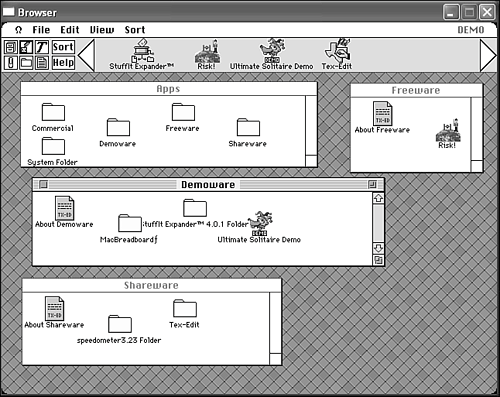Macintosh and Windows
| A few years ago there were several cross-platform emulation systems that let you run Windows on a Macintosh computer, and several that let you run the Mac OS on Windows. The pickings have gotten pretty slim in both categories, but there are still some options. First, Microsoft Virtual PC for Macintosh lets you run Intel-based operating systems on the Mac, pretty credibly. That means your Mac can run MS-DOS, Windows XP, and Linux. Since Mac OS X makes it a snap to copy files to Windows-formatted floppies and to share files over a Windows network, you don't need an emulator just for file transfer anymore. But, an emulator can be a workable alternative to having two computers on your desk or giving up your Mac (just because your company requires you to use some stinkin' Windows applications). In the other direction, emulation of Macs on Windows machines is much less workable, and Apple has put great effort in making it difficult or impossible, in order to protect their market from knock-offs. For one thing, Macs have a large chunk of the operating system in read-only-memory (ROM) chips inside each of their computers, and it's illegal to distribute this code. One solution to this problem is to develop a from-scratch replacement for the licensed ROM code. This is the approach used by Executor, a Mac emulator produced by ARDI. Executor is a virtual Macintosh machine program for reading and writing Macintosh formatted media and running Macintosh programs. Executor runs as a native Windows application, either in full-screen mode or in a window (see Figure 31.7). You can print from Executor to any printer that your system can talk to (local printers, remote printers, faxes if you have the right software, and so on). You can cut and paste text and graphics between Executor and other applications. You can create shortcuts for a Macintosh application so that Executor will start up and run that application. Figure 31.7. Executor runs many Mac programs on the PC under Windows 9x, NT, 2000, and XP. Unfortunately, Executor will not support applications that are "PowerPC-only," which is an increasing proportion. Additionally, although ARDI supports most core operating system services, INITs, CDEVs, and services added after System 7.0 are not supported. ARDI has a compatibility database on its Web site at http://www.ardi.com, which you should check if you're interested in running a particular program. Another Mac emulator is SoftMac, from www.emulators.com/softmac.htm. It too emulates the Motorola 68000 processor series, so it can't run modern PowerPC-only applications, nor any Mac OS version from 8.5 onward. SoftMac achieves better emulation than Executor by relying on the programs in Apple's proprietary ROM chips. If you don't have a working Mac, you can purchase a set of these chips, or pull a set out of a broken Mac. You can also copy the programs out of a functioning Mac, although this is legally dubious procedure. Finally, you should check out PearPC, a free, open-source Power PC Mac emulator available at pearpc.sourceforce.net. PearPC is a work-in-progress, but it can reportedly run Mac OS X 10.3 (for which you must have a license, of course) with networking support on a Windows host. Be warned: This is not a commercial product, so installation and maintenance are going to be a bit on the hairy side. However, it has an enthusiastic community of users and developers, and it's constantly being improved and extended. |
EAN: 2147483647
Pages: 450